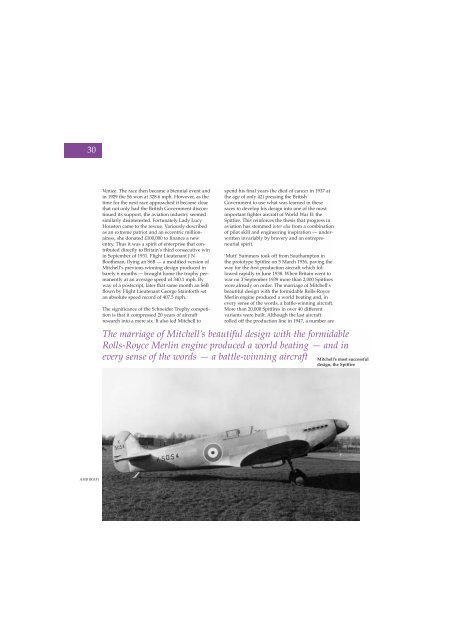Volume 6 No 4 - Royal Air Force Centre for Air Power Studies
Volume 6 No 4 - Royal Air Force Centre for Air Power Studies
Volume 6 No 4 - Royal Air Force Centre for Air Power Studies
You also want an ePaper? Increase the reach of your titles
YUMPU automatically turns print PDFs into web optimized ePapers that Google loves.
30<br />
Venice. The race then became a biennial event and<br />
in 1929 the S6 won at 328.6 mph. However, as the<br />
time <strong>for</strong> the next race approached it became clear<br />
that not only had the British Government discontinued<br />
its support, the aviation industry seemed<br />
similarly disinterested. Fortunately Lady Lucy<br />
Houston came to the rescue. Variously described<br />
as an extreme patriot and an eccentric millionairess,<br />
she donated £100,000 to finance a new<br />
entry. Thus it was a spirit of enterprise that contributed<br />
directly to Britain’s third consecutive win<br />
in September of 1931. Flight Lieutenant J N<br />
Boothman, flying an S6B — a modified version of<br />
Mitchell’s previous winning design produced in<br />
barely 6 months — brought home the trophy permanently<br />
at an average speed of 340.1 mph. By<br />
way of a postscript, later that same month an S6B<br />
flown by Flight Lieutenant George Stain<strong>for</strong>th set<br />
an absolute speed record of 407.5 mph.<br />
The significance of the Schneider Trophy competition<br />
is that it compressed 20 years of aircraft<br />
research into a mere six. It also led Mitchell to<br />
spend his final years (he died of cancer in 1937 at<br />
the age of only 42) pressing the British<br />
Government to use what was learned in these<br />
races to develop his design into one of the most<br />
important fighter aircraft of World War II: the<br />
Spitfire. This rein<strong>for</strong>ces the thesis that progress in<br />
aviation has stemmed inter alia from a combination<br />
of pilot skill and engineering inspiration — underwritten<br />
invariably by bravery and an entrepreneurial<br />
spirit.<br />
‘Mutt’ Summers took off from Southampton in<br />
the prototype Spitfire on 5 March 1936, paving the<br />
way <strong>for</strong> the first production aircraft which followed<br />
rapidly in June 1938. When Britain went to<br />
war on 3 September 1939 more than 2,000 Spitfires<br />
were already on order. The marriage of Mitchell’s<br />
beautiful design with the <strong>for</strong>midable Rolls-Royce<br />
Merlin engine produced a world beating and, in<br />
every sense of the words, a battle-winning aircraft.<br />
More than 20,000 Spitfires in over 40 different<br />
variants were built. Although the last aircraft<br />
rolled off the production line in 1947, a number are<br />
The marriage of Mitchell’s beautiful design with the <strong>for</strong>midable<br />
Rolls-Royce Merlin engine produced a world beating — and in<br />
every sense of the words — a battle-winning aircraft<br />
Mitchell’s most successful<br />
design, the Spitfire<br />
AHB (RAF)
















